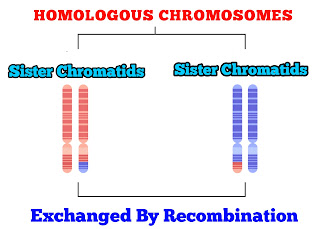Sister chromatids and Homologous chromosomes are two important components of cell division and replication. They play an important role in the formation of daughter cells and the maintenance of genetic information. Both types of chromosomes are similar in structure. But they are different and serve different functions in the cell. The topic of homologous chromosomes vs sister chromatids can be confusing for several reasons.
Don't worry; we are going to explain this topic in a very simple way so that you never get confused. Homologous chromosomes and sister chromatids are related concepts in the context of cell division, particularly during meiosis and mitosis. Here are the key differences between them:
Definition Of Sister Chromatids.
Sister chromatids are identical copies of a single replicated chromosome. They are connected by a structure called the centromere and are produced during the S phase of the cell cycle when DNA is replicated.
Definition Of Homologous Chromosomes.
Homologous chromosomes are chromosome pairs (one from each parent). Chromosome pairs have the same genes but may have different alleles. They are similar in size and carry genetic information for the same traits, but the specific alleles may vary.
Formation Of Sister Chromatids.
Formed through the process of DNA replication. In this process, a single chromosome duplicates to produce two identical sister chromatids.
Formation Of Homologous Chromosomes.
Inherited from each parent, one homologous chromosome comes from the mother, and the other comes from the father.
Role in Cell Division.
Sister Chromatids. Play a crucial role in mitosis and meiosis II. During these processes, sister chromatids separate and are distributed to daughter cells.
Homologous Chromosomes. Play a key role in meiosis I where homologous chromosomes segregate. Segregation results in the distribution of one chromosome from each homologous pair to different daughter cells.
Genetic Variation.
Sister Chromatids. Generally do not contribute to genetic variation since they are identical copies of each other.
Homologous Chromosomes. Contribute to genetic variation through the process of crossing over during meiosis I. Crossing over involves the exchange of genetic material between homologous chromosomes. This leads to a shuffling of genetic information.
Number in Cells:
Sister Chromatids. Two sister chromatids make up a single replicated chromosome.
Homologous Chromosomes. Each cell has a pair of homologous chromosomes (one from each parent). The number of homologous pairs varies among species.
In summary, sister chromatids are copies of the same chromosome resulting from DNA replication. On the other hand, homologous chromosomes are pairs of chromosomes with similar genetic information but potentially different alleles, one from each parent. Sister chromatids are involved in mitosis and meiosis II. On the other hand, homologous chromosomes play a crucial role in meiosis I.
Homologous Chromosomes vs Sister Chromatids.
| Feature | Homologous Chromosomes | Sister Chromatids |
|---|---|---|
| (1) Origin | nherited from each parent (one from mom, one from dad). | Formed through DNA replication of a single chromosome. |
| (2) Genetic Content | Carry genes for the same traits, but may have different alleles. | Have identical genetic information. |
| (3) Connection | Do not have physical connections except during crossing over in meiosis. | Connected by a centromere throughout the cell cycle. |
| (4) Formation | Pair up during meiosis I, aligning with each other. | Formed during the S phase of the cell cycle. |
| (5) Location in Cell Cycle | Found in diploid cells during meiosis I. | Present in diploid cells during the S and G2 phases. |
| (6) Function | Exchange genetic material during crossing over. | Separate during cell division to form two new cells. |
| (7) Number | Two chromosomes in a pair (one from each parent). | One chromosome that has been duplicated during replication. |
| (8) Variability | Genetic variability arises from crossing over. | No genetic variability, as they are identical copies. |
| (9) Role in Meiosis | Separate during meiosis I to form haploid cells. | Separate during meiosis II to produce gametes. |
| (10) End Result | Results in genetically diverse gametes. | Produces two identical daughter cells. |








0 Comments
Kindly share your views